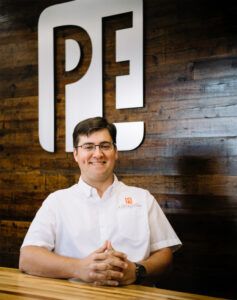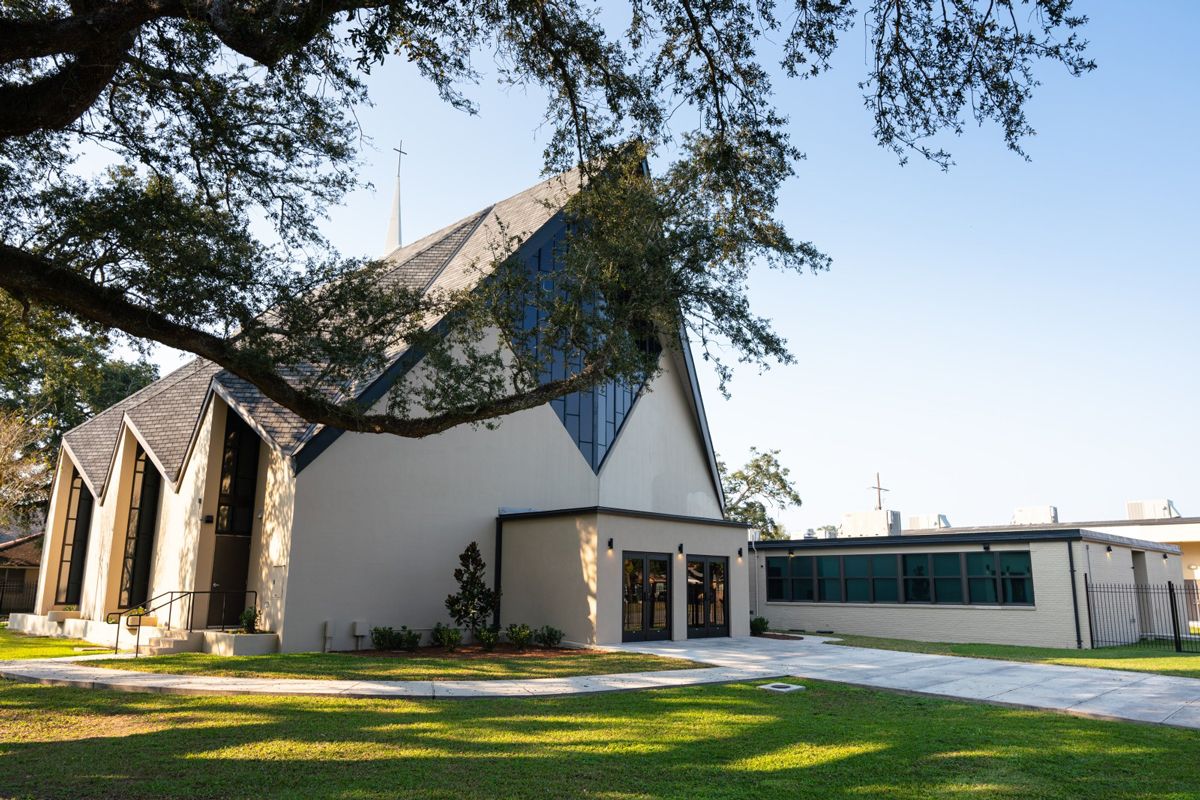In an industry where reputation is built project by project, Perrier Esquerre Contractors (PEC) has established itself as a standout commercial construction firm. Thanks to its unwavering commitment to foundational values, the company, founded in 2014 by Brett Perrier and Keith Esquerré, continues to grow its reputation.
With a combined portfolio exceeding $750 million in completed projects in 2014, Perrier and Esquerré joined forces, envisioning a company that distinguished itself with a deliberate approach to business. When they united, they weren’t simply looking to build structures; they were determined to build a company rooted in principles that often get overlooked in the rush to completion: honesty, integrity and meticulous attention to detail.
We sat down with co-founder Brett Perrier to get his insights on Perrier Esquerre’s journey, philosophy and vision for the future of commercial construction.
Give us a snapshot of your brand.
A leading voice in the commercial contracting industry, Perrier Esquerré Contractors, LLC (PEC) puts people first always and prioritizes relationships above all else. Founded in New Orleans and led by Brett Perrier and KeithEsquerré, PEC was built on an ethical foundation where safety, scheduling, high-quality work and budget efficiency could be equitably provided to clients.
The work has paid off.
With more than 127 projects with repeat clients, 28 industry awards, and climbing—all garnered within a span of 10 years—PEC’s footprint continues to grow across the Greater New Orleans area. When it comes to high-quality commercial construction, it’s impossible to overvalue continuous communication and transparent collaboration.
What type of clients and markets are you targeting?
The main focus of work is centered within the privately owned, commercial construction sector. Our primary project types include retail, high-end restaurants, private practice medical clinics, healthcare clinics, nursing homes, financial institutions, light industrial buildings, veterinary clinics, multifamily and multi-use buildings. The vast majority of our projects are structured as either negotiated, design-build or design-assist contracts.
How does your work cater to today’s end-users?
We are a customer service-based commercial general contractor. Today’s end-users are focused on a high level of sophisticated communication and transparency in every phase of the construction process and are not just looking for the cheapest solution but the one with the longest-term viability for success. From the napkin conceptual design phase of the project all the way through substantial completion, we focus on consistently communicating and collaborating with our clients.
Whether it’s unexpected challenges we encounter on the project, longer than expected lead times on materials that will need to be procured for the project, or even the good news—like when we are ahead of schedule—we communicate early and often to connect transparently.
How is your construction strategy based?
PEC is an industry leader in offering the highest quality services and materials at the best fair market price, while always providing an impeccable collaborative experience and unmatched customer service. Through the utilization of skilled trade members, direct purchasing of materials, and an unyielding commitment to safety, PEC is able to complete projects with a proficiency that is tough to rival.
Repeat clients know it is best practice to begin collaboration early so PEC can identify cost drivers and collaborate directly with design team partners on value engineering ideas and possibilities to help keep projects on schedule and within budget.
What are some of today’s biggest challenges?
Overall, I would say the biggest challenge today is adjusting to the shifting costs of materials. Before 2020, we never really needed to monitor the weekly or monthly commodity markets at the rate that we have needed to monitor them since then. The volatility in the overall cost of goods was a huge challenge to become accustomed to, but unfortunately, this has become our new norm.
We are also seeing some additional pricing increases coming in 2025 for some of our most utilized materials which are composed of timber, steel, aluminum, metal, and plastics. There also is a big challenge in monitoring these commodity prices all while keeping our pricing commitments to our clients.
We stay in front of this challenge by constantly communicating with clients, letting them know each time we hear from the market on increases, and setting deadlines on when selections need to be made to avoid these shifting costs.
What are the biggest challenges in construction or renovating a project?
The biggest challenge in renovations is always the unknown of the existing conditions. Most unknowns aren’t encountered until we actually remove the concrete or sheetrock, remove an existing wall, or expose a wall envelope. So preliminary demo permits can help us assess these unknowns early to allow for a great likelihood of being able to build to the design.
How are you working to promote sustainability?
When opportunities arise in our design-build and design-assist projects, we always think about sustainability in the context of the overall program of the project as well as the specific materials we tend to lean toward. During our Value Engineering exercises with our clients, we consistently explore how we reuse elements of the existing building as opposed to just demolishing and installing new.
Being a GC whose main market is a dense, historic area like the greater New Orleans area, the preservation of old buildings in and of themselves lend to our sustainability initiatives. Some of the larger projects in our history have also required us to refurbish or restore the existing pieces and materials of these old historic buildings, which has been a great source of pride for our team.
What do you see as some of the biggest challenges in construction, moving ahead?
The industry as a whole has accelerated. From the pace at which designers produce drawings to construction timelines, the need to start putting buildings into commerce faster due to shifting costs is becoming remarkable. We are proud to have fully adapted to these challenges, but to continue the pace, as an industry we need to increase our document control measures, produce estimates quicker, and line up our crews and procure materials to execute as fast as the client needs the project turned over.
This is a challenge because as all project team partners accelerate projects – designers, owners, and contractors – the margin of error decreases and needs to be managed. At PEC, we have proprietary tools in place to help manage this process to help reduce the potential for errors in any facet of the project.

Are you optimistic about what you see in your building and construction sectors?
We are very optimistic in our regional market. We are continuously seeing clients eager to progress projects forward. The state of Louisiana is currently housing the largest ongoing construction project in the world, a chemical plant project located in Plaquemines Parish, Louisiana.
Large data centers and car production facilities are also starting construction work throughout the state, so we anticipate that we will see more and more complimentary projects in our market that will get greenlit in order to support the needs of the state’s overall economic momentum. Plant workers and data engineers all need to eat, sleep and play, we will build the restaurants, retail, apartment buildings and hotels that serve those needs.
What trends are you seeing?
The biggest trend I am seeing is the use of cloud-based document control management and project management software programs, like Procore. At PEC, we have been using it for approximately six years, and it seems to have become the norm for every client we talk to today.
They may not use Procore, but each client has their own type of document control/project management software they use that assists in the successful collaboration in the project, and this has been a tremendous game changer in the effectiveness of project communication and process clarity.
Where is your business headed?
Currently, we are very happy with the stability we have built at PEC in just 10 years since our launch. We started with only two employees and in our first year we made $1 million in revenue. This year, we have approximately 30 employees and our revenues are approximately $30 million. We like this steady, organic growth and look forward to continuing on this growth trajectory.
We are currently in the process of moving our current office headquarters to a much larger, more centralized office in Jefferson Parish, Louisiana. This will allow us to help better service our projects, our clients and our trade partners around the region. Our plan is to keep our steady, organic growth pace and, eventually deliver projects all along the Gulf Coast.
Tell us what makes your brand unique?
We do feel like we are not like other typical contractors. This is best exemplified in some of our core values: Smile, People First, Agile Thinkers, Operational Harmony, Smooth Operators and PX4 (Proper Planning Prevents Problems). We feel these core values alone separate us from our competition as every member of our team buys into each core value and it shows from our client feedback on the projects we complete.
Is there a story you can share about a client or job that really shows off your work and ability to engage with the industry?
We are involved with several great industry mentorship organizations. The ACE Mentorship program is a nationally non-profit organization that educates high school students on all aspects of the ACE (Architecture, Contractor, Engineer) industry.
Additionally, we also enjoy being great advocates of the workforce development program, NOTEP. NOTEP partners with the Louisiana Department of Education to offer students academic credit, in addition to earning industry-approved credentials. As advocates, we will conduct site visits with young professionals in this trade school program.
Describe a typical day.
We have three main departments: Operations, Field Operations and Pre-Construction. I am the Director of Pre-Construction, so a typical day for me is finding work.
All joking aside, we are constantly budgeting new projects for clients, finding viable value engineering or cost-saving ideas and options, building new relationships with subcontractors and trade partners, and finalizing contracts with clients so our operations team can get to work in the office and the field. These three departments are always working toward operational harmony to keep the company moving, growing, and making our clients smile.
What was the best advice you ever received?
“Even if you are desperate for work and the market is low, know and understand your worth and never take a project at 0% fee or below costs”
What’s the best thing a client ever said to you?
I have to state first, we are not a disaster-relief contractor. But knowing we live in an area prone to natural disasters in the form of hurricanes, it is only inevitable that we will be called to help out when the time comes.
In 2021, Hurricane IDA hit Louisiana, and we had several projects in progress when this one hit. While servicing those clients, there were several of our other clients who needed sudden disaster recovery support as well. As a customer service-based business, we were called to help. We dropped what we were doing, and helped all our clients with their immediate needs, working long hours, and truthfully, not earning much profit due to our sense of responsibility to help our clients.
After all the dust settled, one of my favorite clients called me just to say, “thank you.” It was something so simple, but so impactful to me, as we really went out on a limb for all our clients to get their business back in commerce as fast as possible after the disaster. But that one client who called just to say a simple “thank you” meant the world to me and reinforced that we are conducting our business the way I always wanted to—putting our clients and human safety first.
View the original article and our Inspiration here


Leave a Reply